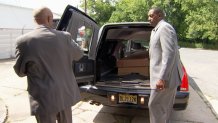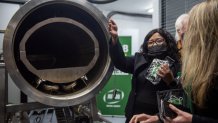Embalming fluid can cause cancer. Concrete production is responsible for up to 8% of the carbon dioxide released into the atmosphere. A traditional funeral is hard on the environment.
Not so natural burials, which forgo embalming fluid and concrete vaults and use only biodegradable containers and garments for an eco-friendly end-of-life choice. Other green choices: water cremation and human composting, in which remains become soil.
Mount Auburn Cemetery in Massachusetts is the only one in the state that is certified by the nonprofit Green Burial Council. After the character Nate Fisher was buried in a natural grave in the 2001 television show Six Feet Under, the cemetery got a surge of calls asking whether they were available.
“The impetus for starting to develop and offer natural burials was really because people starting coming to us inquiring if it would be something we would consider,” said Bree Harvey, vice president of Mount Auburn Cemetery.

Traditional burials in the United States use 4.3 million gallons of embalming fluid each year. They consume 20 million feet of wood, 3.6 millions tons of concrete, 64,500 tons of steel and 17,000 tons of copper and bronze. Even cremation releases more than 500 pounds of carbon dioxide for each body.
Get Tri-state area news delivered to your inbox. Sign up for NBC New York's News Headlines newsletter.
Green burials don't come with those same worries about carbon emissions.
U.S. & World
“Essentially going back to the Earth as we’ve come, dust to dust,” said Ed Bixby, president of the Green Burial Council.
The cemetery, a historic cemetery four miles west of Boston, has a long history of firsts. It was created in 1831 to solve the problem of the increasing number of burials in the city and became a model for the rural or garden cemetery movement. It is the burial site of such notable names as Fannie Farmer of cookbook fame, the architect Buckminster Fuller, Supreme Court Justice Felix Frankfurter, Winslow Homer, the artist, poet Henry Wadsworth Longfellow, and Mary Eddy Baker, the founder of the Christian Science Church.
Listed on the National Register of Historic Places and designated a National Historic Landmark, it tries to maintain a balance between landscaping and monuments, said Matthew Stephens, its CEO. It is one of about 360 cemeteries in the United States and Canada where green burials take place.
“We found green burials which traditionally don’t have as large a monument tied to it, help us preserve this very sacred landscape,” Stephens said.

The country embraced embalming during the Civil War. Ancient Egyptian techniques were updated so that the bodies of some northern soldiers could be sent home by train, according to a 2017 article in Smithsonian Magazine. The body of Abraham Lincoln became the first of a president to be embalmed.
But if natural burials were overtaken by embalming in the days before refrigeration, they are poised to make a comeback now. A survey by the National Funeral Directors Association in 2018 found that 54% of Americans are considering a green burial. By 2022, that number had risen to 60%. Seventy-two percent of cemeteries are finding demand is increasing.
Mount Auburn has had a few hundred natural burials but Stephens believes the numbers will increase.
Another choice is aquamation or water cremation which uses less energy. It’s not a new process. It was patented in 1888 and used in medical schools. The process consists mostly of water, 95% and the lye, said Renee Thompson, the owner of Doc & Smith Funeral Home in Williamstown, New Jersey.


It is more expensive than the traditional cremation, but she expects the price to come down.
"Aquamation is appealing to me for my clients' sake," Thompson said. "I want them to have options. I want to be eco-friendly."
Thompson said education was key. She hopes to hold workshops so that families can learn more about eco-friendly options. If a family knows only about traditional choices, those are the ones they will choose from, she said.
"We definitely have to be conscious of it because climate change is happening," Thompson said. "It’s happening right before our eyes."


Human composting is legal in five states, Washington, Colorado, Vermont and as of the end of September, California. California’s so-called “natural organic reduction” will go into effect in 2027.
A funeral home controls a body’s decomposition, which takes about two months. It costs about $5,000 and creates enough compost to nearly fill the bed for a pickup truck, according to NBC News.
Washington state became the first in the United States to legalize human composting in 2019. Four funeral facilities are now licensed to perform the process, according to Rob Goff, the executive director of the Washington State Funeral Directors Association.
Since natural organic reduction, the formal name for the process, became legal in Washington, 252 people have had their remains composted, according state Department of Health. More than 180,000 people died in the state during the period though 1,200 people have arranged to have their remains composted with Recompose, a Seattle-based company.




